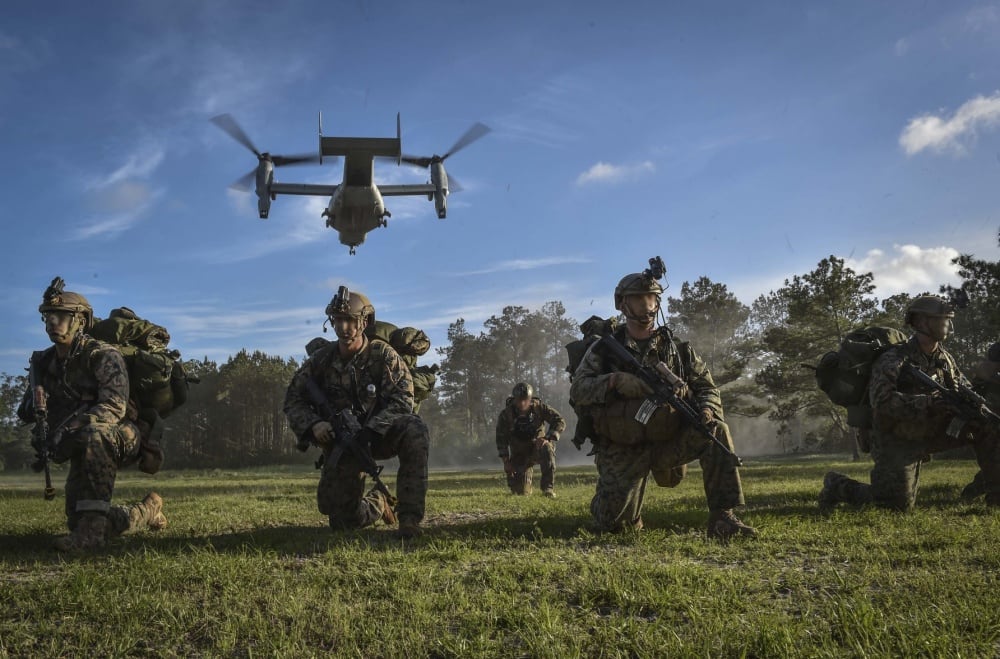The Marine Corps is fielding thousands of its new M27 Infantry Automatic Rifles to grunts across the service and, for now, it’s not buying any more.
The last of the M27s come into the Marine Corps inventory this year and are expected to be in the hands of each infantryman from platoon commander and below by mid-2021, officials said.
The proven weapon has increased lethality among the infantry, experts said. And the 30-round capacity rifle can outrange the M4 by 100 to 150 meters. The Corps also has decided to use the same platform as its squad designated marksman rifle. That is the M38.
RELATED

The M27 saw its origin story begin in the year 2000 as Marines were looking for a lighter, more accurate replacement for the M249 Squad Automatic Weapon. Five years later an initial request to industry went out and by 2010 the Corps had selected the Heckler & Koch 416 and dubbed it the M27 IAR.
Marines first took them on deployment to Afghanistan in 2011.
Some questioned its fire suppression capability over the SAW, but the weapon finally got the blessing of top brass.
Commandant Gen. Robert B. Neller liked what he saw enough to not only push for the M27 to replace the SAW but also the M4, at least within rifle companies and for those working alongside them, such as combat engineers.
The initial goal of getting 6,500 of the M27s into the ranks jumped to 11,000 and plans later called for 15,000 rifles.
Any of the figures would have worked, fitting well below the maximum procurement contract number of 50,184.
Ultimately, the Marines bought just over 14,000 M27s, Manny Pacheco, spokesman for Marine Corps Systems Command, told Marine Corps Times.
Those were purchased at an estimated 1,600 initial purchase followed by 2,600 in 2017, 2,900 in 2018 and 7,000 in 2019.
A little less than half of those, between 6,000 and 7,000, have not yet been fielded.
While Neller repeatedly has said that the weapon has received majority positive reviews from the infantry it has not come into the ranks without its own controversy.
In April 2018, members of the House Armed Services Committee told Neller that they wanted him to provide them an assessment of the service’s view of the Small Arms Ammunition Configuration study and include near and long-term small arms modernization strategy for the Corps.
And future funding for the rifle could be cut or withheld if he didn’t provide that report.
At that point, the Corps had fielded 6,500 M27s.
During a March 2018 House Armed Services Committee hearing Rep. Joe Wilson, R-S.C., grilled Marine leaders about why the weapon wasn’t being provided by a U.S. company.
Lt. Gen. Brian D. Beaudreault, deputy commandant of Plans, Policies and Operations, told the congressman that H&K, a Germany-based company, won the competition and changes now would put fielding behind by two years and substantially raise the price of the contract.
Despite its successes in fielding, certain elite within the Marine ranks decided not to take the new rifle and are sticking with the M4s.
Marine Special Operations Command Raiders continue to carry the M4 carbine. That has had to do both with the profile of missions requiring shorter barrels and also a need for a greater volume of fire they still get from the SAW, a MARSOC spokesman told Marine Corps Times in 2018.
“Given the smaller size of our operational units, the M249′s volume of fire provides a greater tactical benefit than the advantages provided by the M27,” said Maj. Nicholas Mannweiler.
Raiders use an M4 lower receiver, the trigger and housing, attached to a Special Operations Command-upper receiver, the barrel and bolt.
That way operators can swap out components in their weapon system to meet various mission demands.
The SOCOM upper receiver group and M27 lower are not compatible.
“If we need to do shorter suppressed barrels, that’s an option. If we need to have a certain number of weapons within a team or company configured for designated marksman duties, we can do that too,” Mannweiler said.
A 2015 report that was leaked online evaluated the use of the M27 as a designated marksman rifle, the role it has come to play in its M38 configuration.
That report found weapon stoppages at high cyclic rates ― a problem for what’s meant to be the squad’s machine gun.
But, retired Marine Chief Warrant Officer 5 Christian Wade, who worked closely with evaluation, testing and fielding of small arms and training in the Marine Corps, told the website Task & Purpose that the problems in that test were not with the weapon but rather with the aluminum magazines that had feed problems and with the type of ammunition that was being used ― the M855A1 Enhanced Performance Round.
Marines have since adopted a polymer magazine that does not have the feed problems and certain deploying units have obtained another type of 5.56 mm ammunition to correct for past problems with the EPR, he said.
Todd South has written about crime, courts, government and the military for multiple publications since 2004 and was named a 2014 Pulitzer finalist for a co-written project on witness intimidation. Todd is a Marine veteran of the Iraq War.





